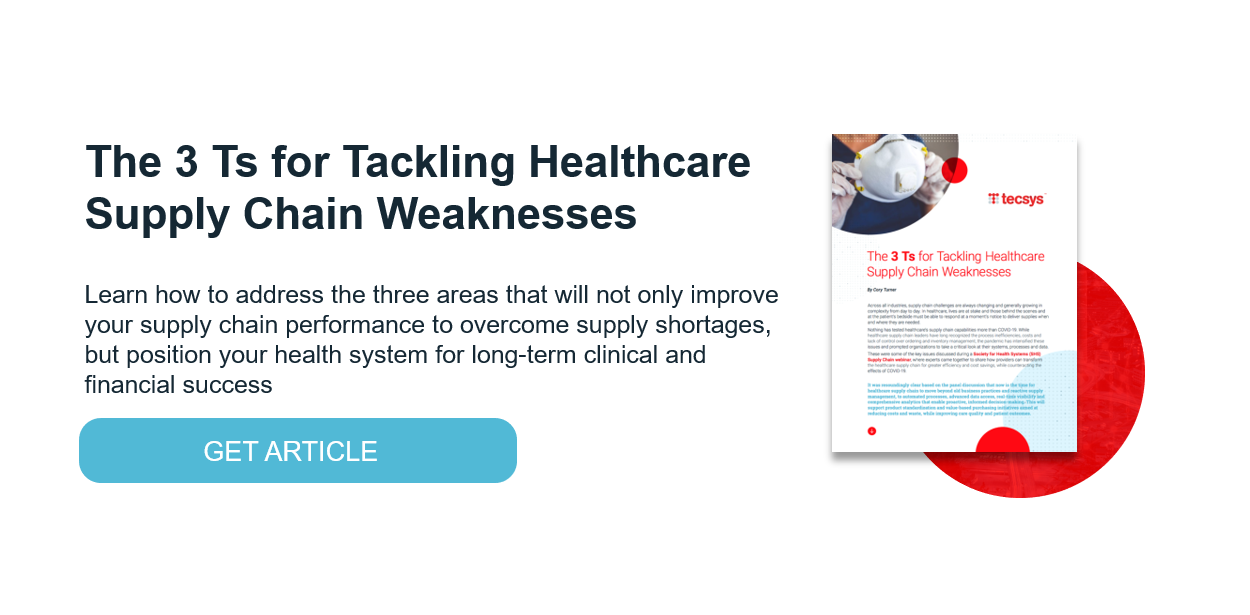Is Healthcare Supply Chain Disruption Keeping You up at Night? Three Questions to Ask Yourself.

The pressing need to diminish healthcare supply chain disruption and increase resiliency has been widely acknowledged among U.S. supply chain leaders since the COVID-19 pandemic hit our shores. Hospitals need to improve the processes by which they procure supplies, manage inventory, document usage and trigger replenishment to not only address the current crisis, but also to prepare for future disruptions, whether that is a natural disaster, infectious disease outbreak or some completely different element.
As stated in the Association for Health Care Resource & Materials Management (AHRMM) 2020 Cost, Quality and Outcomes (CQO) Summit report:
“The COVID-19 crisis has exposed the fragile nature of the health care supply chain. Lack of transparency, demand signals, utilization and robust data analytics are a few of the variables that have hampered our ability to respond to demand for supplies and equipment.”
Three Questions to Ask That Help Reduce Healthcare Supply Chain Disruption
1. Can Your Systems Speak to One Another?
One of the “Post-COVID-19 Mega Trends” identified in the AHRMM 2020 CQO Summit report was: “The acceleration of digital engagement through connecting hardware and software solutions to increase efficiencies, advance capabilities and improve outcomes.”
Take a step back and examine your hospital’s systems and processes. How do you know what supplies you need unless you know what supplies you have used? Does your enterprise resource planning (ERP) system share product data with your electronic health record (EHR) and other point of use (POU) clinical systems? Is data capture and sharing within your systems automated or must staff members manually enter information, adding time/labor and increasing the risk for error? Could your hospital benefit from an operational, clinical and/or financial performance standpoint from greater system integration and process automation?
2. Do You Have Visibility into Supply Inventory?
As stated in the report: “Lack of visibility into inventory has been a problem in healthcare for quite some time… transparency can help smooth operations and reduce costs, which improves organizational profitability and the reduction of waste.”
Pandemic-related supply shortages have forced healthcare leaders to closely scrutinize their inventory management practices and reevaluate possible healthcare supply chain disruption. While you likely know what products your hospital has ordered and in what quantities, what happens after they arrive at your facility? Do you have visibility into supplies in storerooms, on department shelves or in a clinician’s “personal reserves” that he/she holds in fear of running short? Would real-time inventory tracking and traceability from receipt into inventory to utilization help your hospital have the right products in the right quantities in the right places at the right times?
3. Can You Make Data-driven Decisions?
When asked for their opinion on how healthcare supply chain performs with regards to forecasting, the majority of AHRMM 2020 CQO Summit attendees believed it is “somewhat accurate.” The reality is that most hospitals today don’t have accurate, complete and timely supply chain data on which to base their decisions.
Determine what information your hospital needs to accurately forecast supply demand, where this information resides (e.g., supply chain, clinical, financial systems) and what is holding you back from accessing it in a meaningful way. From there you can determine which technology investments can pave the way to advanced analytics for accurate forecasting and demand planning.
Act Now
“Change must begin today if we hope to avoid the level of supply disruption we’ve experienced this year,” states AHRMM in its 2020 CQO Summit Report.
For more information on overcoming current healthcare supply chain disruptions for greater resiliency moving forward, Tecsys is here to help.




